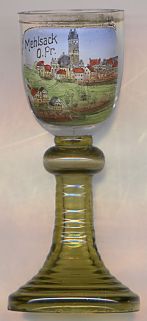

|
| POLSKA | POLAND |
| województwo: Warmińsko-Mazurskie | voivodship: Warmia and Masuria |
| powiat: Braniewski | county: Braniewo |
Pieniężno is situated at an elevation of 111 m on the river Wałsza (German Walscha) in the east of Braniewo county of the Warmian-Masurian voivodeship in northern Poland. has a population of about 2,900 (2005).
 Pieniężno was originally an Old Prussian fort called Malcekuke, loosely translated as "woods of the subterraneous" or "devil's ground".
This was corrupted by Polish settlers to Melzak and by German settlers to Mehlsack (literally "flour sack"). In the 14th century it was
founded as a town west of Lidzbark Warmiński (Heilsberg) in Warmia. Construction of the town's castle began in 1302, when it was used by the monastic
state of the Teutonic Order. Already before 1312 the settlement had obtained the privileges of a town. Both the castle and the town were destroyed during
warfare between the Teutonic Knights and the Kingdom of Poland in 1414. Nicolaus Copernicus was an administrator for the districts Allenstein
(Olsztyn) and Mehlsack for a few years in the early 16th century. From October 1518 until March 1519 Copernicus was based
out of the castle while he settled nearby villages. In 1550 the Prussian army laid siege to the city and partially burned it down. During the Thirty Years'
War (1618–1648) Mehlsack surrendered to the Order, and the castle burned down during Poland's recapture of the town. In 1945 Mehlsack, including its
castle, was 90% destroyed by fighting during World War II and was taken by the Soviet Army, who returned it to Poland in the
Potsdam Conference. Similar to other East Prussian towns, Mehlsack received an entirely new name after the war. It was renamed
Pieniężno after Seweryn Pieniężny, an editor for Gazeta Olsztyńska, a newspaper for the Polish-speaking population of
Warmia that had been banned during the period of Nazi Germany. After the war, Pieniężno lost its status of a city, but regained this status in
1973.
Pieniężno was originally an Old Prussian fort called Malcekuke, loosely translated as "woods of the subterraneous" or "devil's ground".
This was corrupted by Polish settlers to Melzak and by German settlers to Mehlsack (literally "flour sack"). In the 14th century it was
founded as a town west of Lidzbark Warmiński (Heilsberg) in Warmia. Construction of the town's castle began in 1302, when it was used by the monastic
state of the Teutonic Order. Already before 1312 the settlement had obtained the privileges of a town. Both the castle and the town were destroyed during
warfare between the Teutonic Knights and the Kingdom of Poland in 1414. Nicolaus Copernicus was an administrator for the districts Allenstein
(Olsztyn) and Mehlsack for a few years in the early 16th century. From October 1518 until March 1519 Copernicus was based
out of the castle while he settled nearby villages. In 1550 the Prussian army laid siege to the city and partially burned it down. During the Thirty Years'
War (1618–1648) Mehlsack surrendered to the Order, and the castle burned down during Poland's recapture of the town. In 1945 Mehlsack, including its
castle, was 90% destroyed by fighting during World War II and was taken by the Soviet Army, who returned it to Poland in the
Potsdam Conference. Similar to other East Prussian towns, Mehlsack received an entirely new name after the war. It was renamed
Pieniężno after Seweryn Pieniężny, an editor for Gazeta Olsztyńska, a newspaper for the Polish-speaking population of
Warmia that had been banned during the period of Nazi Germany. After the war, Pieniężno lost its status of a city, but regained this status in
1973.
The picture on glass no. 2280 shows the
 Catholic
Catholic
[Text adapted from http://en.wikipedia.org/wiki/Pieniężno]
![[scale]](lineal.jpg)